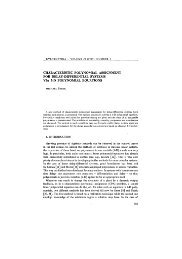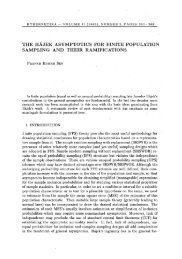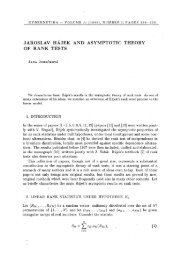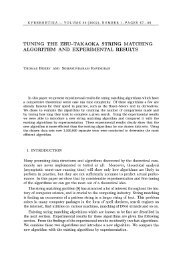polynomial controller design based on flatness - Kybernetika
polynomial controller design based on flatness - Kybernetika
polynomial controller design based on flatness - Kybernetika
You also want an ePaper? Increase the reach of your titles
YUMPU automatically turns print PDFs into web optimized ePapers that Google loves.
Polynomial C<strong>on</strong>troller Design Based <strong>on</strong> Flatness 573<br />
(ii) For the implementati<strong>on</strong>, the RST <str<strong>on</strong>g>c<strong>on</strong>troller</str<strong>on</strong>g> (2) must be written in the proper<br />
operator (P _1 ) which leads to write the RST c<strong>on</strong>trol as:<br />
fl*(p- 1 )tiW = -5*(p- 1 )w(0 + r*(p- 1 )r(t), (8)<br />
with R*(0) = 1.<br />
As the major point is to choose the desired poles, we will see that the <strong>flatness</strong><br />
point of view can fruitfully help us.<br />
3. SHORT SURVEY ON FLATNESS<br />
The flat property, which has been introduced recently [5, 6, 7] for c<strong>on</strong>tinuous-time<br />
n<strong>on</strong>linear systems, leads to interesting points of view for c<strong>on</strong>trol <str<strong>on</strong>g>design</str<strong>on</strong>g>. In the following,<br />
a short review about <strong>flatness</strong> of systems and the applicati<strong>on</strong> of this property<br />
to <str<strong>on</strong>g>design</str<strong>on</strong>g> a <str<strong>on</strong>g>c<strong>on</strong>troller</str<strong>on</strong>g> will be given. The interested reader may find more details in<br />
the quoted literature and the references therein.<br />
A system described by:<br />
XW=f(x,u), (9)<br />
where x is the state vector of dimensi<strong>on</strong> n, and u is the c<strong>on</strong>trol signal, possesses the<br />
<strong>flatness</strong> property (or is flat) if there exist a variable z:<br />
z = h(x,u,u( 1 \... ,u (a )), (10)<br />
where aGN, two functi<strong>on</strong>s A(-)and -B(-), and an integer (3 such that:<br />
z = A(z,...,^)),<br />
u = B(z,...,z^+1 )).<br />
The selected output z is called a flat output and, obviously, there is no uniqueness.<br />
But, as it has been observed <strong>on</strong> numerous examples, the flat output has a simple<br />
and physical meaning.<br />
Roughly speaking, the implicati<strong>on</strong>s of <strong>flatness</strong> are of very importance in several<br />
ways for c<strong>on</strong>trol. For moti<strong>on</strong> planning, by imposing a desired trajectory <strong>on</strong> the flat<br />
output, the necessary c<strong>on</strong>trol to generate the trajectory, can be obtained explicitly<br />
(without any integrati<strong>on</strong> of the differential equati<strong>on</strong>s). The desired trajectory, zd(t),<br />
must be ((3 + l)-times c<strong>on</strong>tinuously differentiable. For feedback c<strong>on</strong>trol which <strong>on</strong>ly<br />
ensures a good stabilizati<strong>on</strong> around the desired moti<strong>on</strong> Zd(t).<br />
All these points, which have been formalized through the Lie-Backlund equivalence<br />
of systems in [6, 8], lead to propose a n<strong>on</strong>linear feedback which ensures a<br />
stabilized tracking of a desired moti<strong>on</strong> for the flat output. This methodology has<br />
been applied <strong>on</strong> many industrial processes as it has been shown previously, for instance,<br />
<strong>on</strong> magnetics bearings [18], chemical reactors [25], cranes or flight c<strong>on</strong>trol<br />
[19] or turning process [22, 23], am<strong>on</strong>g many other examples.<br />
The main objective of the <strong>flatness</strong> <str<strong>on</strong>g>based</str<strong>on</strong>g> <str<strong>on</strong>g>c<strong>on</strong>troller</str<strong>on</strong>g> is to obtain the asymptotic<br />
tracking of a desired trajectory and this can be ensured through the following steps:






